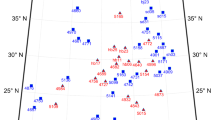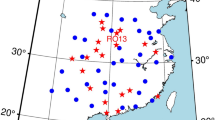Abstract
Integer ambiguity resolution at a single receiver can be achieved if the fractional-cycle biases are separated from the ambiguity estimates in precise point positioning (PPP). Despite the improved positioning accuracy by such integer resolution, the convergence to an ambiguity-fixed solution normally requires a few tens of minutes. Even worse, these convergences can repeatedly occur on the occasion of loss of tracking locks for many satellites if an open sky-view is not constantly available, consequently totally destroying the practicability of real-time PPP. In this study, in case of such re-convergences, we develop a method in which ionospheric delays are precisely predicted to significantly accelerate the integer ambiguity resolution. The effectiveness of this method consists in two aspects: first, wide-lane ambiguities can be rapidly resolved using the ionosphere-corrected wide-lane measurements, instead of the noisy Melbourne–Wübbena combination measurements; second, narrow-lane ambiguity resolution can be accelerated under the tight constraints derived from the ionosphere-corrected unambiguous wide-lane measurements. In the test at 90 static stations suffering from simulated total loss of tracking locks, 93.3 and 95.0% of re-convergences to wide-lane and narrow-lane ambiguity resolutions can be achieved within five epochs of 1-Hz measurements, respectively, even though the time latency for the predicted ionospheric delays is up to 180 s. In the test at a mobile van moving in a GPS-adverse environment where satellite number significantly decreases and cycle slips frequently occur, only when the predicted ionospheric delays are applied can the rate of ambiguity-fixed epochs be dramatically improved from 7.7 to 93.6% of all epochs. Therefore, this method can potentially relieve the unrealistic requirement of a continuous open sky-view by most PPP applications and improve the practicability of real-time PPP.
Similar content being viewed by others
References
Banville S, Langley RB (2009) Improving real-time kinematic PPP with instantaneous cycle-slip correction. In: Proceedings of ION GNSS 22nd international technical meeting of the satellite division, Savannah, US, pp 2470–2478
Basu S, Groves KM, Basu Su, Sultan PJ (2002) Specification and forecasting of scintillations in communication/navigation links: current status and future plans. J Atmos Sol-Terr Phys 64(16): 1745–1754
Bisnath S, Gao Y (2007) Current state of precise point positioning and future prospects and limitations. In: Sideris MG (eds) Observing our changing Earth. Springer, New York, pp 615–623
Bruyninx C (2004) The EUREF Permanent Network: a multi- disciplinary network serving surveyors as well as scientists. GeoInformatics 7: 32–35
Dai L, Wang J, Rizos C, Han S (2003) Predicting atmospheric biases for real-time ambiguity resolution in GPS/GLONASS reference station networks. J Geod 76(11–12): 617–628
Dilßner F, Seeber G, Wübbena G, Schmitz M (2008) Impact of near-field effects on the GNSS position solution. In: Proceedings of ION GNSS 21st International Technical Meeting of the Satellite Division, Savannah, US, pp 612-624
Dow JM, Neilan RE, Rizos C (2009) The International GNSS Service in a changing landscape of Global Navigation Satellite Systems. J Geod 83(3–4): 191–198
Ge M, Gendt G, Rothacher M, Shi C, Liu J (2008) Resolution of GPS carrier-phase ambiguities in precise point positioning (PPP) with daily observations. J Geod 82(7): 389–399
Geng J (2009) Rapid re-convergence in real-time precise point positioning with ambiguity resolution. In: Proceedings of ION GNSS 22nd international technical meeting of the satellite division, Savannah, US, pp 2437–2448
Geng J, Teferle FN, Shi C, Meng X, Dodson AH, Liu J (2009) Ambiguity resolution in precise point positioning with hourly data. GPS Solut 13(4): 263–270
Geng J, Meng X, Dodson AH, Teferle FN (2010a) Integer ambiguity resolution in precise point positioning: method comparison. J Geod. doi:10.1007/s00190-010-0399-x
Geng J, Teferle FN, Meng X, Dodson AH (2010b) Towards PPP-RTK: ambiguity resolution in real-time precise point positioning. Adv Space Res. doi:10.1016/j.asr.2010.03.030
Gregorius TLH, Blewitt G (1999) Modeling weather fronts to improve GPS heights: a new tool for GPS meteorology?. J Geophys Res 104(B7): 15261–15279
Han S, Rizos C (2000) GPS multipath mitigation using FIR filters. Surv Rev 35(277): 487–498
Hauschild A, Montenbruck O (2009) Kalman-filter-based GPS clock estimation for near real-time positioning. GPS Solut 13(3): 173–182
Hernández-Pajares M, Juan JM, Sanz J, Colombo OL (2000) Application of ionospheric tomography to real-time GPS carrier-phase ambiguities resolution, at scales of 400-1000 km and with high geomagnetic activity. Geophys Res Lett 27(13): 2009–2012
Kashani I, Wielgosz P, Grejner-Brzezinska D (2007) The impact of the ionospheric correction latency on long-baseline instantaneous kinematic GPS positioning. Surv Rev 39(305): 238–251
Kouba J (2009) A simplified yaw-attitude model for eclipsing GPS satellites. GPS Solut 13(1): 1–12
Laurichesse D, Mercier F, Berthias JP, Broca P, Cerri L (2009) Integer ambiguity resolution on undifferenced GPS phase measurements and its application to PPP and satellite precise orbit determination. Navig J Inst Navig 56(2): 135–149
Melbourne WG (1985) The case for ranging in GPS-based geodetic systems. In: Proceedings of first international symposium on precise positioning with the global positioning system, US, pp 373–386
Senior KL, Ray JR, Beard RL (2008) Characterization of periodic variations in the GPS satellite clocks. GPS Solut 12(3): 211–225
Shan S, Bevis M, Kendrick E, Mader GL, Raleigh D, Hudnut K, Sartori M, Phillips D (2007) Kinematic GPS solutions for aircraft trajectories: identifying and minimizing systematic height errors associated with atmospheric propagation delays. Geophys Res Lett 34: L23S07. doi:10.1029/2007GL030889
Shi C, Zhao Q, Geng J, Lou Y, Ge M, Liu J (2008) Recent development of PANDA software in GNSS data processing. In: Proceedings of the society of photographic instrumentation engineers, 7285:72851S doi:10.1117/12.816261
Stoew B, Nilsson T, Elgered G, Jarlemark POJ (2007) Temporal correlation of atmospheric mapping function errors in GPS estimation. J Geod 81(5): 311–323
Teunissen PJG (1995) The least-squares ambiguity decorrelation adjustment: a method for fast GPS integer ambiguity estimation. J Geod 70(1–2): 65–82
Teunissen PJG (1996) An analytical study of ambiguity decorrelation using dual frequency code and carrier phase. J Geod 70(8): 515–528
Teunissen PJG (1997) On the sensitivity of the location, size and shape of the GPS ambiguity search space to certain changes in the stochastic model. J Geod 71(9): 541–551
Teunissen PJG, de Jonge PJ, Tiberius CCJM (1997) The least-squares ambiguity decorrelation adjustment: its performance on short GPS baselines and short observation spans. J Geod 71(10): 589–602
Teunissen PJG, Verhagen S (2009) The GNSS ambiguity ratio-test revisited: a better way of using it. Surv Rev 41(312): 138–151
Verhagen S, Teunissen PJG (2006) New global navigation satellite system ambiguity resolution method compared to existing approaches. J Guid Control Dynam 29(4): 981–991
Wang J, Stewart MP, Tsakiri M (1998) A discrimination test procedure for ambiguity resolution on-the-fly. J Geod 72(11): 644–653
Wang J, Satirapod C, Rizos C (2002) Stochastic assessment of GPS carrier phase measurements for precise static relative positioning. J Geod 76(2): 95–104
Wu JT, Wu SC, Hajj GA, Bertiger WI, Lichten SM (1993) Effects of antenna orientation on GPS carrier phase. Manuscr Geod 18(2): 91–98
Wübbena G (1985) Software developments for geodetic positioning with GPS using TI-4100 code and carrier measurements. In: Proceedings of first international symposium on precise positioning with the global positioning system, US, pp 403–412
Zumberge JF, Heflin MB, Jefferson DC, Watkins MM, Webb FH (1997) Precise point positioning for the efficient and robust analysis of GPS data from large networks. J Geophys Res 102(B3): 5005–5017
Author information
Authors and Affiliations
Corresponding author
Rights and permissions
About this article
Cite this article
Geng, J., Meng, X., Dodson, A.H. et al. Rapid re-convergences to ambiguity-fixed solutions in precise point positioning. J Geod 84, 705–714 (2010). https://doi.org/10.1007/s00190-010-0404-4
Received:
Accepted:
Published:
Issue Date:
DOI: https://doi.org/10.1007/s00190-010-0404-4




